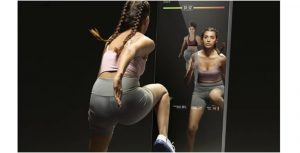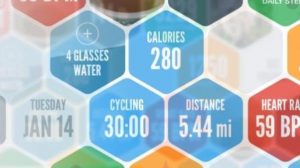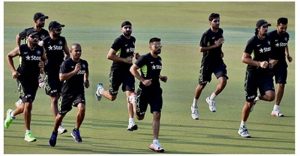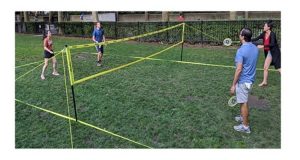
Our BPM (or beats per second) is a good indicator of whether we are exercising right or not. Here we take a look at how heart beat monitors can help us in our fitness goals and which ones to buy.
There are several fitness reality show on television (such as “The Biggest Loser”) where several obese people work out (much harder than what they usually do). And all of them wear a heart rate monitor. Its because because they are so out of shape (and with health risks) that their trainers need to know that their hearts are not being overworked. These monitors also monitor the rate at which their heart is pumping.
What used to be a tool for only professional athletes is now available to the common man.
How Does a Heart Rate Monitor Work?
Traditional heart rate monitors (HRM) have a chest strap that picks up impulses from your heart and transmits them to the monitor, usually a watch in your wrist. The heart rate monitor watch processes the data received from the strap and displays it to you. Your heart beat is then read constantly and displayed.
The main job of all heart rate monitors (HRM), strapless or otherwise, is to measure the speed your heart is beating at. This is shown on the receiver which is usually a wrist watch. There are also more specialized monitors designed for triathletes and for cyclists which are designed to be multi-purpose fitting on a bike as well as on your wrist. This specialized type will have a set of unique functions such as wattage output, and pedaling cadence, useful functions if you ride a bike! These will usually cost more than a non specialist one and may require some accessories. Many monitors today come with an added attachment so that your HRM can be attached to your bike, but these do not have the specialized bike functions.
How to Know the Maximum Rate of Your Heart?
The formula to calculate the maximum heart rate is easy. Take the number 220 and minus it with your age.
So for example, if your age is 25, then your maximum heart rate is said to be 195. This is the calculation used in heart rate monitors and is the reason why you’ll need to enter your age.
Meanwhile, professional athletes undergo further tests to determine more accurately what are their maximum heart rates.
However, for most of us, this simple formula is good enough to know the maximum heart rate.
How to Get the Most from Your Heart Rate Monitor?
To set up most monitors you’ll need to enter your age, weight and some other information so that the device can display statistics for your training session or workout. Most keep track of the length of the session, your max and min heart beat as well as the average and number of calories burned. They will monitor your ideal heart rate training range depending on what you’re trying to achieve and then beep if you fall outside of the target range. The target range minimum is usually 60% of your maximum heart beat and the maximum is 80% of your maximum heart beat.
There are also some monitors that will can work out your V02 maximum (a measure of how fit you are), some have built in GPS and can calculate altitude and ascent which can be useful when you’re on the bike. All of the higher end heart rate monitors and a few of the entry level ones can download your workout data to your computer so allowing you record and monitor all of your workouts so that you can keep track of progress.
No matter what level of fitness and what your goals and targets are monitoring your heart beat and keeping track of progress is invaluable. You can make sure you’re not over training or over doing it and seeing your progress is a great motivator. You don’t have to be a competitive athlete to get the most out of your HRM. Using the data will help you design your ideal training schedule, even if it’s just a brisk walk 3 or 4 times a week.
By using the data you can develop a plan that incorporates your minimum and maximum heart rate zones setting up a schedule that varies in duration and intensity. This will help you get the most from each session and you’ll know what adjustments need to be made to the plan by looking at your heart rate data.
Benefits of Heart Rate Monitor
The biggest advantage of training on heart beat is that it shows you what intensity your on. This is useful because it makes a big difference on the results you’re going to get. For example train using a low intensity to burn fat, whilst higher intensity helps grow thick muscles, which helps strength but lowers endurance. Depending on your schedule or needs this makes a big difference. It’s also advisable to mix up endurance training with strength training.
Another benefit is that progress is easier to register. Without the numbers it’s difficult to notice the littler things. But with the math on your side suddenly differences of 2BPM using the same intensity can be noticed. To maximize this consider keeping a journal to see your progression over time.
Buying a Heart Beat Monitor
So which heart rate monitor should you buy? Well it depends on your budget, needs and personal preference. There are three types. Heart rate monitors with chest band and continuous reading, strapless heart rate watches and strapless with continues reading. The latter is extremely rare and expensive and currently only offered by 1 supplier named epulse.
- HRM with Strap: The first option is the most common. Upon purchase you will get a chest band and a watch. The watch communicates with the band and keeps progress of your BPM the whole time; it’s very precise and can be bought cheap.
Obvious drawback is the strap, which some users (especially women) complain about. Another issue with this type of HRM is that it is reliant on the chest strap making good contact with the skin of the wearer to pick up the signal. Usually you’ll have to make the electrodes on the strap damp and in some cases a special gel is required. Synthetic fabrics can interfere with the signal by building up a static charge, as can microwaves, radios and other electronic devices.
On the plus side this style of heart rate monitor is the most accurate with a host of functions. The decision as to which type of monitor you’ll want will depend on the type of exercise you do and what you aim to achieve using your HRM.
- Strapless Monitors: Second option is rather new and is called strapless. In the box you’ll find a watch with two metal circles on top. The watch cannot detect your heart rate by wrist but requires you to hold the two metal detectors after which the device calculates the beats within 5 seconds. It’s often used in gyms because it doesn’t require a band and is still pretty cheap. But you cannot keep track of your beats unless you keep hold of the detectors. This makes it a solution named BPM on demand.
By far and away the biggest benefit of the strapless heart rate monitor is that it can measures your heart beat without using a chest strap. The vast majority of strapless heart rate monitors are worn on your wrist and they work by having one or two sensors on the watch. When you put your finger(s) on the sensors the watch reads your heart beat and displays it. There are also designs that have a ring sensor that fits around your finger, ones that strap to your upper arm and ones that can be held in the hand and used for walking, jogging and running.
- Third option is rare and expensive; at least $100+. The company epulse recently launched a heart rate monitor that doesn’t require a chest band and detects your heart rate continuously. The first version had obvious drawbacks, for one it was rather clumsy and worked on triple A batteries. But their second attempt is lighter, has a rechargeable battery and is more easy to use. The epulse2 has enjoyed great reviews and is recommended for people looking to avoid straps and praying for continuous feedback.
Depending on the style you choose the heart rate monitor may show your heart beat continuously while others can only monitor your heart beat when you use the touch sensor. These non-continuous styles are cheaper (about the same price as a regular digital watch) but you do have to use one or two fingers to take a reading.
E-Pulse Monitor
This newer strapless heart rate monitor is banded around the forearm (no more strapping around chest) for use and has not only a pulse monitor and calorie counter but other features as well. You can set the pulse monitor to your preference of high, low and it will also give you an average.
Wearing a strapless heart rate monitor will mean you no longer have to remove clothing to attach it your chest. If you are a man and have a hairy chest, that in itself can report questionable results due to poor body contact.
These models have larger LED for easy readability, are compact in size, are waterproof, and powered by triple-A batteries . The integration of microchip technology and light sensor, similar to medical heart rate monitors, gives you a more accurate reading of your heart rate.
This is much more comfortable than wearing a chest strap.
Cycling Heart Rate Monitors
Cycling is a really prominent sport. You might very well know about cycling terms like Lycra and aerodynamics. But do you know about maximum heart rate? What about terms like aerobic and anaerobic?
These concern your heart, the main organ that is pumping blood to your leg muscles to keep cycling. You should in fact, get a monitor that measures the rate your heart beats per minute. Why is this so? The number reason is that you could find out your maximum rate of your heart and then adjust your cycling intensity to be slightly lower to achieve the aerobic level.
Aerobic to Anaerobic
If you want to make cycling the staple or backbone of your exercise regime, then you would want to dive into the aerobic zone now and then. During the aerobic zone, you will be performing optimally without tiring. This is because anything that goes beyond the aerobic zone is the called anaerobic.
During the anaerobic phase, your body does not have enough oxygen to use and resort to building up lactic acid. Lactic acid will cause a person to feel the burn in the muscles when pushing an activity too hard.
Our body utilizes primarily oxygen during the aerobic phase. Therefore, we do not tire as easily during the aerobic. So how is it that we can go into the aerobic zone? The rule of thumb is to measure your heart rate and then take 65 or 85 percent from it. This percentage of your maximum heart rate tells you how hard you should cycle to be in the aerobic phase. For example, if your maximum heart rate is 195 then your aerobic rate (if 65 percent) is 126 heart beats per minute.
Heart rate monitors are extensively used by elite cyclists. Sometimes, their entire work outs all depend on the rate itself. This is a great device to measure your performance and adjust accordingly; another benefit is that you do not tire out easily and know your limits.
Heart Rate Monitor Rating
Heart rate monitors are all different, are suited for different types of activities, different sizes of people, and some of them interact only with a particular piece of equipment.
One of the things to look for is the heart rate monitor rating.
- Check the heart rate monitor rating to see if it will work with the type of sport you are planning on doing.
- If you are looking to monitor your heart rate in the gym, in an aerobics class, or on the treadmill, then most any monitor will work for you. But, if you are going to be running outside in the dark, then you might want one with a light.
- If you are going to be monitoring your heart while swimming, then you need one that is totally waterproof and easy to use with wet hands.
- Some monitors will store more information than others, and allow you to repeat workouts, or even download your data to your computer.
- In general, you don’t require lots of features, as most of it may not get used anyways.
As with most gadgets, do read the user manual to know more about the various options available.
No longer are heart rate monitors just for the professional athletes and the good thing is that they are much cheaper now. They are becoming useful tools to recover from surgery or a cardiac disease, or to get fitter and more in shape, or just act as a motivator to do more exercise and burn more calories.
Before you pay for any type of heart rate monitor, you need to do your research (you do get strapless models as well nowadays). Check out some of the heart monitor watches online before you buy one.









Leave a Reply